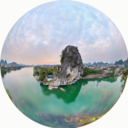0 Likes
The Chacao channel is a marine channel in southern Chile. It is located on the X Region of Los Lagos. Separate the American continent from the north coast of the island of Chiloé joining the Coronados Gulf with the Gulf of Ancud. The road communication between both sides is via a ferry service linking the towns of Pargua Chacao on the mainland and on the Big Island.
The Spanish marine Francisco de Ulloa, in 1553, was the first European to recognize this channel.
Boats in Pargua in the extreme continental. Arriving ferries to the mainland. The eastern entrance is between the tip Colonel, on the continent, and the tip Tres Cruces in Chiloe Island 41 ° 49'30 "S 73 ° 29'30" W. The west entrance is between the tip Chocoy, on the continent, and the tip Guapacho at the northern end of the island of Chiloe 41 ° 46'01 "S 73 ° 52'10" W. The channel half east-west direction and its total length is 14 nautical miles (25.928 km). Its width varies from just over 1 nautical mile (1,852 km) in the rock swirls, up to 2 ½ nautical miles (4.63 km) near its western entrance. [Edit] Topography Formed after the retreat of the ice during the last glaciation (Würm or Wisconsin glaciation) and subsequent emergence of the Pacific Ocean, the appearance of the north bank differs profoundly from the south bank. The lands of the north coast or inland are high and steep. The island of Chiloé are of moderate height, height rises from east to west. The channel is deep and you can navigate ships of large size and depth. In the months of February, March and April tend to be dense fog banks. Within the channel there are three islands, from west to east are Doña Sebastiana, Pigs and Lacao. [Edit] Navigation Tidal Tides and currents are produced with great intensity in the channel and are the main concern for navigation. Sometimes its waters have the look of a fast flowing river. In the rock swirls, near the eastern mouth of the channel, it experiences a tidal range of 3-5 meters in syzygy with current speeds of 3-9 knots. [Edit] Lighthouse Authorities There are lighthouses, buoys and beacons and navigational aids within. At the western entrance is the wreck of the ship hull Liberian "Andros Coral". In his course there are reefs and low so for foreign vessels is required where practical for navigation. There are special instructions for your navigation. History This arm of the sea was not an obstacle for the expansion huilliche south, who managed to cross and settle in Chiloé past the year 1000. C., displacing the inhabitants chonos the Patagonian archipelagoes. In the Chacao channel during the course of 1567 established the first permanent Spanish settlement in the archipelago: the strong San Antonio de Chacao. Later, the military enclaves of San Miguel and San Antonio Calbuco Ribera de Carelmapu, founded in 1602 and 1603, respectively, colonization expanded into new areas of coastal and continental Chiloé island. http://es.wikipedia.org/wiki/Canal_de_Chacao




